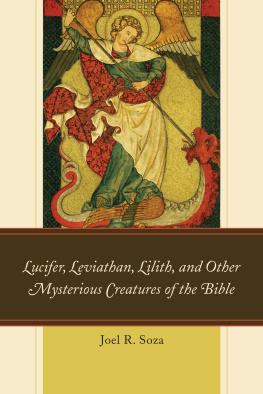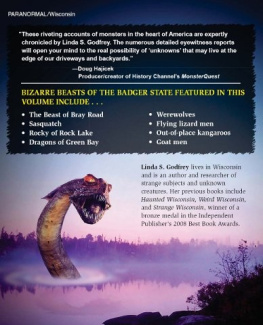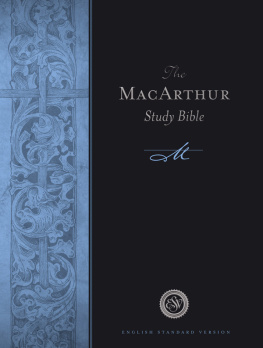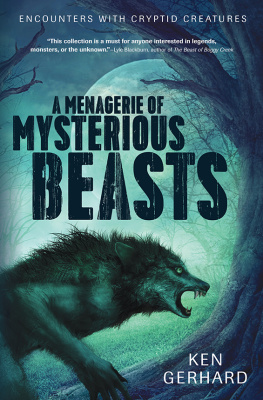Lucifer, Leviathan, Lilith,
and Other Mysterious Creatures
of the Bible
Joel R. Soza
Hamilton Books
An Imprint of
Rowman & Littlefield
Lanham Boulder New York Toronto Plymouth, UK
Copyright 2017 by Hamilton Books
4501 Forbes Boulevard, Suite 200, Lanham, Maryland 20706
Hamilton Books Acquisitions Department (301) 459-3366
Unit A, Whitacre Mews, 26-34 Stannary Street,
London SE11 4AB, United Kingdom
All rights reserved
Printed in the United States of America
British Library Cataloguing in Publication Information Available
Library of Congress Control Number: 2017931006
ISBN: 978-0-7618-6897-2 (pbk : alk. paper)ISBN: 978-0-7618-6898-9 (electronic)
 TM The paper used in this publication meets the minimum requirements of American National Standard for Information Sciences Permanence of Paper for Printed Library Materials, ANSI/NISO Z39.48-1992.
TM The paper used in this publication meets the minimum requirements of American National Standard for Information Sciences Permanence of Paper for Printed Library Materials, ANSI/NISO Z39.48-1992.
Preface
This book is intended for a wide audience of readers. Its primary target is university and seminary students who are looking to enter into the theological thought world of the bible in a sophisticated way. However, scholars will also find it edifying, and intellectually rigorous lay persons of faith will find it stimulating, curios, and challenging. Professional clergy will advance their understanding of the thought world and theological message of the bible and will be more capable preachers, teachers, and expositors of the sacred text.
The study that is engaged in in this book is a theological pursuit of how, through one particular avenue of thought, the biblical writers framed the struggle of good and evil in the world. Through the use of imagination and playing off of common human apprehensions, their employment of creative imagery and portrayal of mysterious non-human beings brought out to the foreground in a resourceful way the taking on of some of humankinds other-worldly fears. Ultimately in the grand drama of scripture of course, these fears are put to rest by Gods victory over all things evil through the kingdom of his messiah.
The bibles theological message is certainly diverse. The pursuit of this book is just one of many that could be undertaken, not only as relates to the overall theological message of the bible, but also as it relates to the specific topic of the struggle of good and evil and the mystery of the hidden world of spiritual darkness that exists in the biblical realm. To enter into this biblical realm requires great effort on the part of the bible reader to disengage pre-conceived notions of how the bible functions and to be prepared to engage a thought world that dates back millennia and crosses cultural and linguistic boundaries. Often times, a mistake is made when even a sophisticated biblical reader thinks of only having to cross linguistic lines when reading and studying the bible, rather than being aware that not only must language be translated, i.e. Hebrew, Aramaic, and Greek, but culture has to be translated as well. This can be the more challenging and urgent task.
The book is organized around three main chapters. The first concerns Lucifer, the second concerns Leviathan, and the third concerns Lilith. The ring of alliteration in the title is for remembrance purposes and to be catchy to create curiosity in would be readers. But the book is not just about, or even primarily about, Lucifer, Leviathan, and Lilith. Interwoven in these chapters is an exploration of other mysterious creatures that appear in the bible in an attempt to be as comprehensive as possible. The bible, whether one approaches it as a book of living faith, or merely as a historic exposition of ancient religion, can be a strange and mysterious world. This author does write from a faith perspective, and a Christian faith perspective at that, but it is the purpose of this book to tap into some of the mystery to be found in the pages of the bible as it relates to the various creatures that appear to be images of the struggle between God and the forces of chaos opposed to him. I hope you find the journey beneficial and intriguing.
Note
John H. Walton, The Lost World of Genesis One (Downers Grove, IL.: InterVarsity Press, 2009), pp.9-15.
Introduction
Some years ago I was participating in a conference for biblical scholars. The venue for the event was at a lodge in one of the state parks in Ohio. While doing some reading in my room, I noticed that there was literature laid about which was advertising another conference that was soon to be hosted at the lodge. The conference would be devoted to the topic of Bigfoot, the legendary creature which roams the woodlands of North America. My interest was piqued, in that such fascination with the celebrated beast could lead to organized, formal, and even intellectual conferences that would draw paying participants. In considering the bible that I was studying in the moment, it occurred to me that the bible itself has its own fascinating world of the strange, mysterious, and mythical. This planted a seed which I am now seeking to water and nourish through the writing and publication of this book.
Bigfoot, as the creature is called in the United States, What captures my attention is not the so-called sightings, but the amount of hours spent by people observing the lake for any signs of the aquatic animal. Although Ive never been a believer, I must confess that if I had opportunity to be at or on the lake, my head would be turning in every direction to watch for Nessie, as the monster is warmly known by locals. And it is this sort of thing that motivates me to pursue this topic in the writing of this book. What is it about us humans, even us modern day humans, living well beyond the enlightenment and the rise of the scientific age that causes us to be curious about the existence of creatures that most would write off as superstitions? And, how does the bible, written in antiquity when superstitions were much more prevalent, capture this human fascination by portraying its theological message at times with mysterious and even perhaps mythological beings?
It has become evident in the last century or so in the western part of the world that the frightening creature or monster business is indeed big business. The young 19th century English girl, Mary Wollstonecraft Shelley, could have never envisioned that when she first sat down to write the story of Frankenstein as a sort of competitive pleasure, that books, stage plays, and eventually movies about her creature would be the result of her efforts. These are just a few examples of societys fascination with monsters and mysterious creatures, and time would fail me to speak of the creature from the black lagoon, the mummy, the phantom of the opera, or mermaids and unicorns. The bible, written some two millennia or more ago is very insightful then, as to how it makes use of such creatures, real or imagined, to demonstrate the long-standing feud between chaos and order, or good and evil.
Returning momentarily to the topic of the present day public interest in Nessie, one finds that she, as a monster of the waters, is predated by mariners tales of long ago. The legendary Norwegian Sea monster known as the Kraken is one such example, as are the stories of deep sea creature encounters by New England mariners of the early 19th century. In fact, stories of watery monsters are to be found in the earliest human epics of the account of creation of the cosmos. The Mesopotamian creation epic Enuma Elish, which dates to the 12th century BCE and perhaps earlier, tells tales of the rebellious goddess Tiamat, who employs sea creatures and deities to carry out her work of theocide.










 TM The paper used in this publication meets the minimum requirements of American National Standard for Information Sciences Permanence of Paper for Printed Library Materials, ANSI/NISO Z39.48-1992.
TM The paper used in this publication meets the minimum requirements of American National Standard for Information Sciences Permanence of Paper for Printed Library Materials, ANSI/NISO Z39.48-1992.